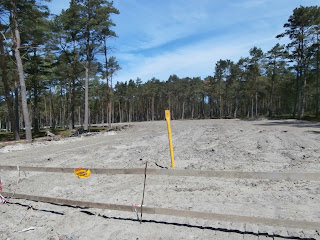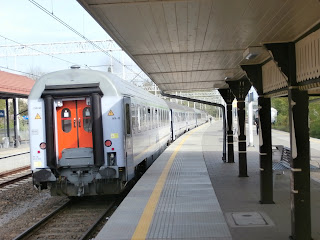Holidaying came earlier than usual this year, with my late-spring / early-summer trip being brought forward by my mother’s complicated surgery (hip transplant) scheduled for 24 May. Mum is pulling through, though she will be on the mend by around the end of August. Given the short notice in which she had been notified about the admission to the hospital, I had to plan everything less than two weeks in advance. After last year’s foray to the seaside with the bikes, I decided to repeat it this year, however wanted to visit more than a dozen place within a few days of stay.
To the right, a sunset snapped on Sunday, 15 May, a few minutes past 9:00 p.m., from the nearly empty beach in Rewal (eight hours of drive from Warsaw). Polish sea shore faces north-west in most places hence is ideal for watching the sun going down into the sea. The only drawback was the temperature – wind chill below +10C.
The church in Trzęsacz a few centuries ago was built 2 kilometres from the beach. Over hundreds of years, the Baltic Sea has taken away much of the land and ruins of the church crumbled down the cliff. Currently the remnants are protected from the forces of the nature. Note the trees are not in leaf yet. Cold April and first half of May delayed vegetation.
This horrific building on the western edge of Pobierowo is a Gołębiewski Hotel, still under construction. I can safely bet it would offer accommo- dation to more than 1,000 guests. An ugly blot on the landscape that will add up to droves of people invading seaside resorts in July and August. Worth noting such edifices are not a rarity in southern Europe.
The desolated Niechorze brought to my mind the streets of Slovenian Portoroz. Just like most towns and villages I visited, it was nearly empty. Tourists begin to turn up in early June, to flood the area during school holidays and then to disappear at the beginning of September.
I made several stopovers along the way, to stroll around, or just to sit on a bench and read a book. My vehicle was protected by a decent bicycle lock, purchased for 120 zlotys in Decathlon, well ahead I had to boycott the retailer. The lock is solid enough to give me comfort of protection against theft.
Although the season was low, the narrow-gauge railcar kept running between Trzęsacz and Pogorzelica, here caught in a station in Niechorze. Note the lighthouse in the distance.
The R10/R13 cycling trail between Niechorze and Pogorzelica runs through a picturesque forest parallel to the railway. This part of it is a proper cycling path, accessible by any bike and offering conditions to move quite fast (and in a lovely scenery).
Between Pogorzelica and Mrzeżyno in the middle of a forest one can come across the Baltic Pipe gas pipeline. The first question which popped to my mind when I saw such wide corridor in a chopped down forest was about the diameter of the pipe(s). Hope it is launched soon.
The cycling trail in some places offers rest / leisure spots for cyclists – here on of them in the middle of a forest close to Pogorzelica. I have run across few cyclists on my way, but blame the low season and windy weather for that.
Kołobrzeg which I visited on my way from Rewal (first lodgings) to Ustka (second one) was anything, but enchanting to me. I see no rationale for popularity of the city. The only nice place I found there was a park separating the beach and the city – a gorgeous area for strollers and cyclists.
To the right, the beach on the eastern edge of Ustka, lit by the late-afternoon sun. Here not as few tourist as in western parts of the seaside, also fewer visitors from Germany (and cars on German plates) can be spotted.
As it turned out at the Ustka train station, wczasy wagonowe are not necessarily the relic of the past. Those carriages sitting at the sidings seemed inhabited by people, who came there by the silver Volkswagen SUV with the trailer. As I peeked into the carriages, accommodation conditions in the carriages dating back probably to 1960s wer dismal.
Probably few know Ustka once had a shipyard. These days premises are rundown and skeleton of ship outside the shipyard building is turning into rust. If those facilities were to be torn down and the land cleared up, attractive tourist area would emerge.
Ustka has made a tremendous use of the EU funds to restore its buildings to bring back the climate of a fishmen’s town. The sad side effect is that too much soil has been concreted over. This mistake will need to be reversed in some time.
Sand dunes in Słowiński Park Narodowy are the only ones in Poland. I popped over there on the warmest day of my stay (Thursday, 19 May) when temperature topped +26C. Waddling up and down through the moving deep sand in full sunshine was not the biggest pleasure, yet the sight of unusual landscapes make up for inconveniences.
Of course, one cannot walk anywhere, but has to stick to fenced-off trails. Yet, as you can see, the dunes do not resemble a typical deserts – several coniferous plants have grown on the sand and prevent it from moving too fast.
The last snap comes with an Intercity train about to depart from Ustka station. The town has three IC connections per pay, offering direct journeys to Poznań, Wrocław, Katowice, Kraków and Przemyśl. To my surprise, there is no direct connection to Warsaw, which is a bit of a letdown.


















No comments:
Post a Comment